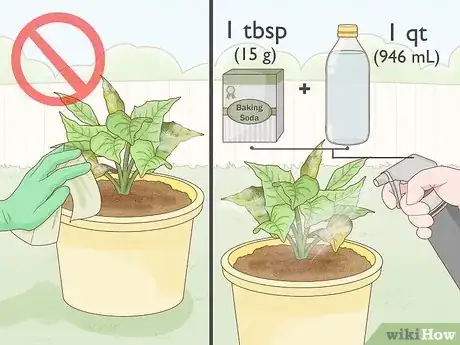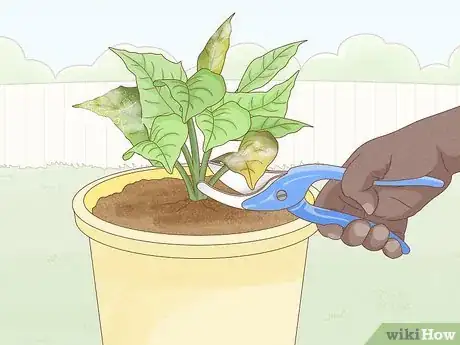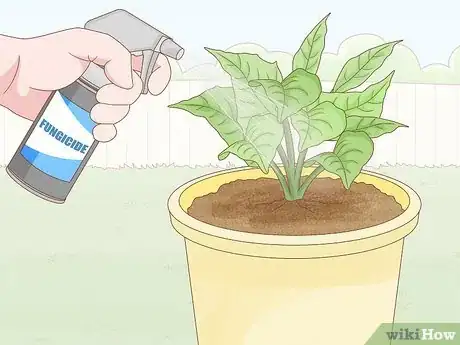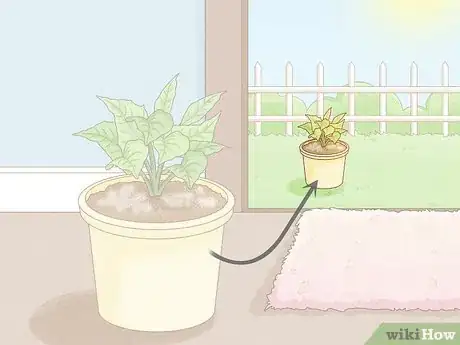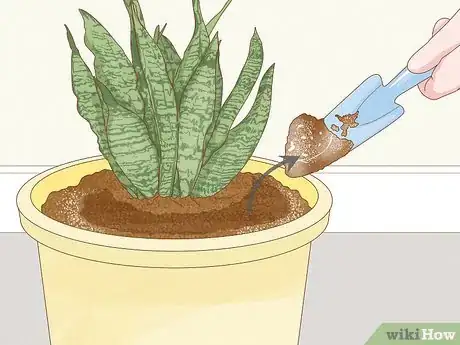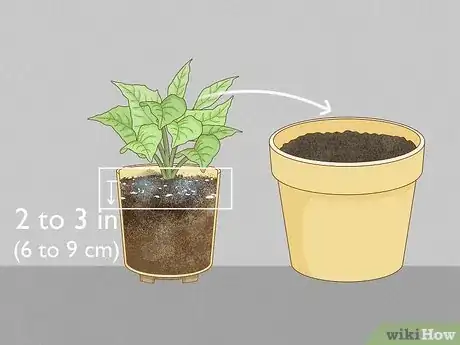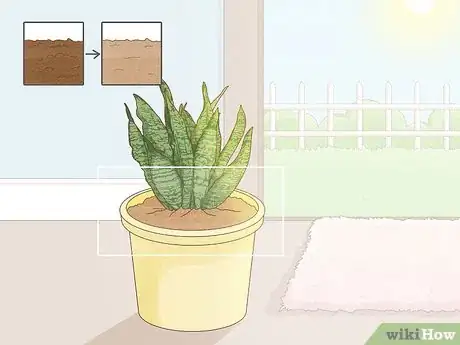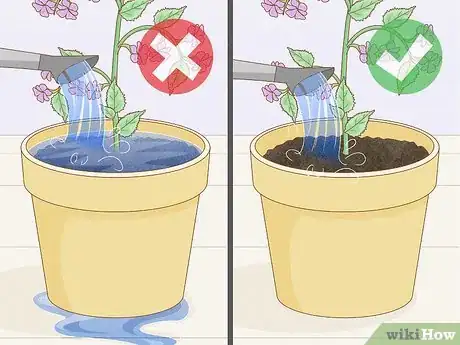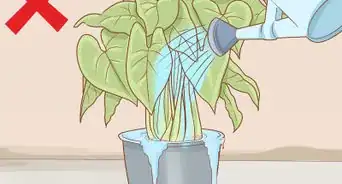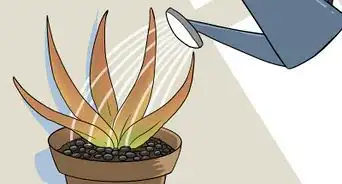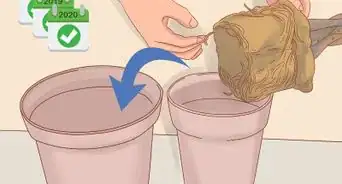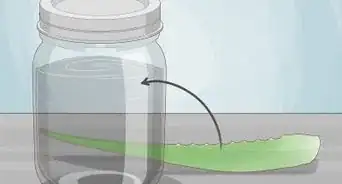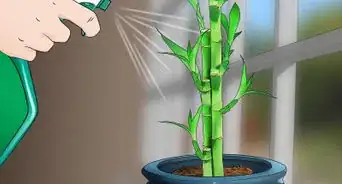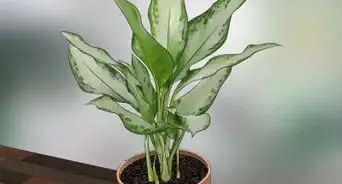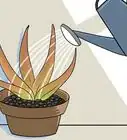This article was co-authored by Chai Saechao and by wikiHow staff writer, Aly Rusciano. Chai Saechao is the Founder and Owner of Plant Therapy, an indoor-plant store founded in 2018 based in San Francisco, California. As a self-described plant doctor, he believes in the therapeutic power of plants, hoping to keep sharing his love of plants with anyone willing to listen and learn.
There are 18 references cited in this article, which can be found at the bottom of the page.
wikiHow marks an article as reader-approved once it receives enough positive feedback. This article received 25 testimonials and 80% of readers who voted found it helpful, earning it our reader-approved status.
This article has been viewed 960,265 times.
Are there patches of a white, black, or dark green substance lingering on or around your houseplant? This powdery or fuzzy substance could be mold, but don’t worry! Mold on houseplants can be caused by a number of easily fixable things, such as over-watering, lack of sunlight, or poor ventilation. In this article, we’ll teach you how you can quickly get rid of mold on your houseplants and prevent it from coming back. So, grab your gardening tools because we’ve got a plant to save!
Things You Should Know
- Wipe mold off your houseplant’s leaves or remove the affected areas entirely with gardening shears.
- Scoop away mold on your plant’s soil with a spoon or trowel or repot it with sterile soil to keep the mold from spreading.
- Make sure your houseplant is in a well-lit space with plenty of airflow to prevent the mold from returning.
Steps
Removing Mold from Leaves
-
1Mist leaves affected by powdery mold with baking soda and water. It may be tempting to wipe powdery mold off leaves, but don’t do it! This could easily spread mold spores and cause the mold to come back. Instead, mix 1 tbsp (15 g) of baking soda with 1 qt (946 mL) of water together in a spray bottle. Spritz both sides of the leaves thoroughly and let the excess water drip off.[1]
- Some houseplant owners use a mouthwash solution to wipe down their leaves instead of baking soda. There isn't scientific evidence to prove this is more effective at removing mold, but you could try it by mixing 1 part mouthwash with 3 parts water.[2]
- Powdery mold makes leaves look like they’ve been dusted with flour.
-
2Cut off leaves affected by white or black mold with scissors or shears. Identify which leaves have mold by inspecting them thoroughly—don’t forget to check the underside! Then, use a pair of garden scissors or shears to trim the leaf at the stem. This will improve the airflow around the plant, preventing more mold from growing.[3] Toss the moldy leaves aside and dispose of them, keeping them away from other plants.[4]
- If there’s still visible mold on the leaves you wiped, cut off the leaves.
- White mold usually has a fuzzy texture and looks like cotton.
- Black or sooty mold is dark in color and usually has a splotchy pattern.[5]
Advertisement -
3Spray your affected plant with a natural fungicide and monitor it closely. Once the mold is removed, give your plant a nice coating of fungicide spray to keep the mold from coming back. Keep spraying until beads of fungicide are running off the leaves. Wait 7 days, spray your plant again, and monitor it to see if the mold comes back.[6]
- If the mold does comes back, keep the plant in a room around 70 °F (21 °C) near an open window with drier soil.
- Ready to buy your natural fungicide? Check out our Lowe's promo codes and Home Depot promo codes first to see if you can save on your purchase.
-
4Take your plant outside to keep the mold from spreading. Bring your houseplant outside when preparing to remove mold. Cleaning the plant can cause mold spores to float through the air and infect other areas of your house. So, to be safe, place the plant outside and work on it there.[7]
- Make sure set the plant down in a spot that’s away from trees and other plants, so you don’t put them at risk.
Removing Mold from Soil
-
1Scoop the mold away with a spoon or shovel. If you see mold on your houseplant’s soil, it’s likely confined to the top layer. Use a spoon or small gardening trowel (depending on the size of your plant’s pot) to remove the top layer of soil and lingering mold.[8]
-
2Repot your plant if there’s mold under the surface layer of soil. Mold likes to grow, travel, and spread, especially in moist, wet conditions. If you notice that there are patches of mold 2 to 3 in (6 to 9 cm) below the top layer or soil, take your plant out of the pot and repot it. Knock out at much soil from your plant’s roots as you can; otherwise, the mold may return in the new soil and cause root rot.[9]
-
3Add a natural anti-fungal to your soil to keep the mold away. This step is optional, but the mold spores will likely spread throughout the soil again if you don’t do this. Try sprinkling or spraying cinnamon, baking soda, apple cider vinegar, or neem oil on top of the soil. These ingredients naturally repel mold without harming your houseplant.
- Mist the plant’s leaves, stem, and soil with a cinnamon spray made by dissolving 1 tbsp (15 g) of cinnamon in 1 c (237 mL) of warm water.[10]
- Cover the soil around your plant’s stem with a dusting of baking soda to stop mold from growing.
- Spray a solution of 2 tbsp (30 g) of apple cider vinegar with 1/4 gal (946 mL) of water to kill traces of mold on and around the plant, as the antimicrobial properties of apple cider vinegar are antifungal.[11]
- Spritz neem oil around the base of your plant generously to stop mold from spreading.
-
4Let the soil dry before watering again. Poke your finger in the soil every few days. Once it’s dry 2 to 3 in (6 to 8 cm) down, it’s time to water. Water slowly to let the water sink and drain through the soil, stopping once water is flowing out of the pot’s drainage holes.[12] Only drying the soil when it’s wet can stop any lingering mold spores from growing as there will be no moisture to latch onto.
- If your houseplant requires moist soil, wait until the top layer or surface is dry.
Preventing Further Mold Growth
-
1Pot your plant with sterile soil. The right soil can help prevent mold from growing and spreading in the future. Always repot new and owned plants in a sterile soil, as these have been treated with heat or chemicals to lessen the amount of bacteria in the soil. This way, you keep any unwanted mold spores from contaminating the new pot.[13]
- Choose a soil that fits your plant’s needs. For instance, potting mixes are generally used to pot houseplants because they have a light texture and high drainage.[14]
-
2Place your plant in a well-lit environment with good airflow. Mold grows on houseplants when there isn’t enough light or ventilation, so make sure your houseplant has plenty of sunshine, airflow, and space to grow. Move your plants to a well-lit room, open windows, place an oscillating fan near your plants, and don’t put too many plants in one pot. Implementing these simple things prevents not only mold growth but also helps your plant thrive.[15]
- Powdery mildew or mold, also known as Erysiphe diffusa, can appear on the upper leaf of a plant when not enough light is present.[16]
- Black mold, also known as Stachybotrys chartarum, can grow on the soil and surfaces around the plant when it’s overwatered.
- White mold, also known as Sclerotinia stem rot, can effect the leaves and tissues of houseplants in humid conditions.[17]
-
3Water your plant only when necessary. Over-watering your houseplants can lead to mold problems. Always check that the top layer of soil is dry before watering, especially since each plant type requires different amounts of water.[18]
- Sometimes, the soil takes longer to dry than normal, and that’s okay! Test the dryness of the soil with your finger before watering, rather than following a strict watering schedule.
- Along with this, make sure the pot has drainage holes that let excess water flow out of the soil.[19]
- Some houseplant owners pour lemon juice on the top layer of soil after watering to prevent mold from returning. Although lemon juice is proven to have some antimicrobial properties, this hack hasn’t been scientifically tested.[20]
-
4Keep your plant and pot clean. Dead and decomposing leaves and dust can cause mold problems, so make sure to remove them. Trim away dead parts of your plant, and regularly wipe down the leaves with a damp cloth.[21]
- Keep your houseplant collection manageable. Sometimes less is more, especially when it comes to having the time to care for each plant properly.
Community Q&A
-
QuestionCan I put activated charcoal in the soil to prevent mold?
 Community AnswerYes, you can. Charcoal will absorb excess water in your plant's pot, and overwatering is what causes mold.
Community AnswerYes, you can. Charcoal will absorb excess water in your plant's pot, and overwatering is what causes mold. -
QuestionHow easy is it for a plant to grow mold in an apartment?
 Community AnswerPretty easy, especially if you have poor air circulation and live in a humid climate.
Community AnswerPretty easy, especially if you have poor air circulation and live in a humid climate. -
QuestionDoes a mixture of peroxide and water help kill the mold?
 Community AnswerIt can, but be careful. If your plant is delicate, or if you use too much peroxide, it can hurt the plant. And I wouldn't use it on any herb or vegetable plants, either.
Community AnswerIt can, but be careful. If your plant is delicate, or if you use too much peroxide, it can hurt the plant. And I wouldn't use it on any herb or vegetable plants, either.
References
- ↑ https://fiddleleaffigplant.com/how-to-prevent-and-treat-powdery-mildew-on-a-fiddle-leaf-fig/
- ↑ https://www.growingagreenerworld.com/controlling-or-eliminating-powdery-mildew/
- ↑ https://youtu.be/A_xsjZ139g4?t=72
- ↑ https://hgic.clemson.edu/factsheet/houseplant-diseases-disorders/
- ↑ https://www.missouribotanicalgarden.org/gardens-gardening/your-garden/help-for-the-home-gardener/advice-tips-resources/pests-and-problems/diseases/black-mildew
- ↑ https://youtu.be/hTc6zapri5g?t=234
- ↑ https://www.indoorplantsforbeginners.com/why-are-my-indoor-plants-growing-mold/
- ↑ https://www.indoorplantsforbeginners.com/why-are-my-indoor-plants-growing-mold/
- ↑ https://www.indoorplantsforbeginners.com/why-are-my-indoor-plants-growing-mold/
- ↑ https://youtu.be/yqShivalV2I?t=168
- ↑ https://www.ncbi.nlm.nih.gov/pmc/articles/PMC5788933/
- ↑ https://www.naplesgarden.org/container-gardening-watering-your-container-gardening/
- ↑ https://www.aafa.org/mold-allergy/
- ↑ https://www.wildinteriors.com/blog/best-soil-for-houseplants
- ↑ http://www.gardeningknowhow.com/houseplants/hpgen/preventing-mold-in-the-soil-of-a-houseplant.htm
- ↑ https://cropprotectionnetwork.org/encyclopedia/powdery-mildew-of-soybean
- ↑ https://crops.extension.iastate.edu/encyclopedia/white-mold
- ↑ https://www.aafa.org/mold-allergy/
- ↑ https://www.indoorplantsforbeginners.com/why-are-my-indoor-plants-growing-mold/
- ↑ https://www.ncbi.nlm.nih.gov/pmc/articles/PMC4708628/
- ↑ https://extension.umn.edu/plant-diseases/white-mold-garden
- ↑ https://preservation.library.harvard.edu/managing-mold-contamination
About This Article
Mold is a common problem on houseplants, especially if your plants are overwatered or don’t get enough sunlight. Fortunately, most mold infestations in houseplants are treatable. If you notice mold on the soil around your plant, scoop it away with a garden spade or a spoon. If there’s too much mold to scoop away easily, repot the plant in fresh soil. Give the soil a chance to dry out a bit before watering the plant again, since moisture can encourage new mold growth. Check that the soil is dry to a depth of at least 2 to 3 inches (5.1 to 7.7 cm), or wait until just the surface is dry if it’s a type of plant that requires a lot of moisture. To keep the mold from coming back, sprinkle a natural antifungal, such as baking soda, cinnamon, or apple cider vinegar, onto the top surface of the soil. Any time you notice dead leaves or other debris in the soil, pick them out quickly so they don’t encourage new mold to grow. Sometimes, a mold infestation can spread to the plant itself. Active mold will look like soft, fuzzy patches on the leaves or stems, while dormant mold may look powdery and pale. If you notice mold on your plant, take it outside and set it somewhere away from other plants in your yard or garden. Wet a paper towel and use it to carefully wipe the mold off of the leaves. Switch to a fresh paper towel after each wipe. If you can still see mold on any of the foliage, trim the affected leaves off with a sharp knife or pair of garden shears and throw the leaves away. Finally, spray your plant with a store-bought plant fungicide and bring it back inside. To keep the mold from coming back, keep your plant in a bright, dry place where it can get good air circulation. Maintain a temperature of around 70° F (21.1° C), which should keep most plants warm enough without encouraging mold. Always plant new houseplants in sterile soil, and avoid overwatering your plants, since mold loves moisture. Trim away dead leaves and flowers as soon as you notice them, and wipe your leaves regularly to remove dust, debris, and spores. To learn more about mold prevention, read on!
